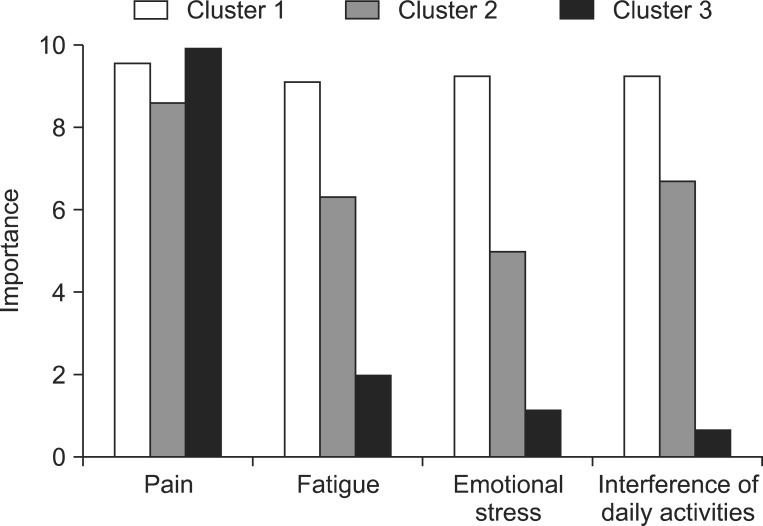Ann Rehabil Med.
2014 Feb;38(1):77-83. 10.5535/arm.2014.38.1.77.
The Relationships Between Determination of Treatment Success and Emotional Factors in Patients With Chronic Musculoskeletal Pain
- Affiliations
-
- 1Department of Rehabilitation Medicine, Bundang Jesaeng General Hospital, Seongnam, Korea. equoo@naver.com
- KMID: 2266544
- DOI: http://doi.org/10.5535/arm.2014.38.1.77
Abstract
OBJECTIVE
To investigate the relationship of the patient's criteria of successful treatment to emotional factors in patients with chronic musculoskeletal pain.
METHODS
Patients who visited our outpatient hospital due to chronic musculoskeletal pain were evaluated using a questionnaire survey. Patients were evaluated with the Patient-Centered Outcomes Questionnaire (PCOQ) to investigate their expectation and criteria for success regarding treatment of chronic musculoskeletal pain. Beck Depression Inventory and State-Trait Anxiety Inventory were used to check for psychological variables. Correlations among each of the variables were evaluated statistically.
RESULTS
Patients with higher levels of depression and anxiety needed larger improvements to consider the treatment as a success in the pain domain (depression, r=0.398, p=0.04; anxiety, r=0.447, p=0.02) and emotional distress domain (depression, r=0.617, p=0.001; anxiety, r=0.415, p=0.03), but had lower level of expectation of the treatment in the pain domain (depression, r=-0.427, p=0.01; anxiety, r=-0.441, p=0.004), emotional distress domain (depression, r=-0.454, p=0.01; anxiety, r=-0.395, p=0.04), and interference of daily activities domain (depression, r=-0.474, p=0.01; anxiety, r=-0.396, p=0.04). Patients were classified into 3 clusters based on the importance rating of each domain via a hierarchical analysis. The cluster of the patients with the higher rating of importance across all domains (importance of pain domain, 9.54; fatigue domain, 9.08; emotional distress domain, 9.23; interference of daily activities domain, 9.23) had the highest level of depression and anxiety.
CONCLUSION
Consideration of psychological factors, especially in patients who require larger improvements in all treatment domains, may be helpful for the successful treatment of chronic musculoskeletal pain.
Keyword
MeSH Terms
Figure
Reference
-
1. Daniel M, Long C, Murphy W, Kores R, Hutcherson W. Therapists' and chronic pain patients' perceptions of treatment outcome. J Nerv Ment Dis. 1983; 171:729–733. PMID: 6644281.
Article2. Brown JL, Edwards PS, Atchison JW, Lafayette-Lucey A, Wittmer VT, Robinson ME. Defining patient-centered, multidimensional success criteria for treatment of chronic spine pain. Pain Med. 2008; 9:851–862. PMID: 18950440.
Article3. Robinson ME, Brown JL, George SZ, Edwards PS, Atchison JW, Hirsh AT, et al. Multidimensional success criteria and expectations for treatment of chronic pain: the patient perspective. Pain Med. 2005; 6:336–345. PMID: 16266354.
Article4. Thorne FM, Morley S. Prospective judgments of acceptable outcomes for pain, interference and activity: Patient-determined outcome criteria. Pain. 2009; 144:262–269. PMID: 19446958.
Article5. O'Brien EM, Staud RM, Hassinger AD, McCulloch RC, Craggs JG, Atchison JW, et al. Patient-centered perspective on treatment outcomes in chronic pain. Pain Med. 2010; 11:6–15. PMID: 19732374.6. Sanderson KB, Roditi D, George SZ, Atchison JW, Banou E, Robinson ME. Investigating patient expectations and treatment outcome in a chronic low back pain population. J Pain Res. 2012; 5:15–22. PMID: 22328831.7. Casarett D, Karlawish J, Sankar P, Hirschman K, Asch DA. Designing pain research from the patient's perspective: what trial end points are important to patients with chronic pain? Pain Med. 2001; 2:309–316. PMID: 15102235.
Article8. Zeppieri G Jr, Lentz TA, Atchison JW, Indelicato PA, Moser MW, Vincent KR, et al. Preliminary results of patient-defined success criteria for individuals with musculoskeletal pain in outpatient physical therapy settings. Arch Phys Med Rehabil. 2012; 93:434–440. PMID: 22277243.
Article9. Beck AT, Ward CH, Mendelson M, Mock J, Erbaugh J. An inventory for measuring depression. Arch Gen Psychiatry. 1961; 4:561–571. PMID: 13688369.
Article10. Han HM, Yum TH, Shin YW, Kim KH, Yoon DJ, Jung GJ. A standardization study of Beck Depression Inventory in Korea. J Korean Neuropsychiatr Assoc. 1986; 25:487–500.11. Lim KB, Park HJ, Kim SH, Kim DY, Kim SS. Quality of life and anxiety in patients with acute and chronic pain. J Korean Acad Rehabil Med. 2010; 34:752–757.12. Kim JT, Shin DK. A study based on the standardization of the STAI for Korea. New Med J. 1978; 21:69–75.13. Kim JH, Seok JH, Jon DI, Hong HJ, Hong N, Kim SJ, et al. Psychological characteristics of patients with depressive symptoms at the initial diagnosis of breast cancer: preliminary results. J Breast Cancer. 2008; 11:83–88.
Article14. Lim KB, Kim JY, Lee HJ, Kim DY, Kim JM. The relations among pain, emotional and cognitive-behavioral factors in chronic musculoskeletal pain patients. J Korean Acad Rehabil Med. 2008; 32:424–429.15. Kim SJ, Kim WS, Kang YK, Lee SH, Cho SH. Influencing psychologic factors and stress in patients with chronic pain. J Korean Acad Rehabil Med. 2000; 24:1161–1167.16. Afari N, Buchwald D. Chronic fatigue syndrome: a review. Am J Psychiatry. 2003; 160:221–236. PMID: 12562565.
Article17. Kurtze N, Gundersen KT, Svebak S. The role of anxiety and depression in fatigue and patterns of pain among subgroups of fibromyalgia patients. Br J Med Psychol. 1998; 71(Pt 2):185–194. PMID: 9617472.
Article18. Kurtze N, Svebak S. Fatigue and patterns of pain in fibromyalgia: correlations with anxiety, depression and co-morbidity in a female county sample. Br J Med Psychol. 2001; 74(Pt 4):523–537. PMID: 11780799.
Article
- Full Text Links
- Actions
-
Cited
- CITED
-
- Close
- Share
- Similar articles
-
- The Relations among Pain, Emotional and Cognitive-behavioral Factors in Chronic Musculoskeletal Pain Patients
- The Association of Workplace Psychosocial Factors and Musculoskeletal Pain Among Korean Emotional Laborers
- Relationships among the Pain Belief, Pain Coping, and Pain Disability of Patients with Chronic Musculoskeletal Pain
- The Pharmacologic Management of Chronic Non-Cancer Pain
- Effects of Emotional Labor and Workplace Violence on Physical and Mental Health Outcomes among Female Workers: The 4th Korean Working Conditions Survey



